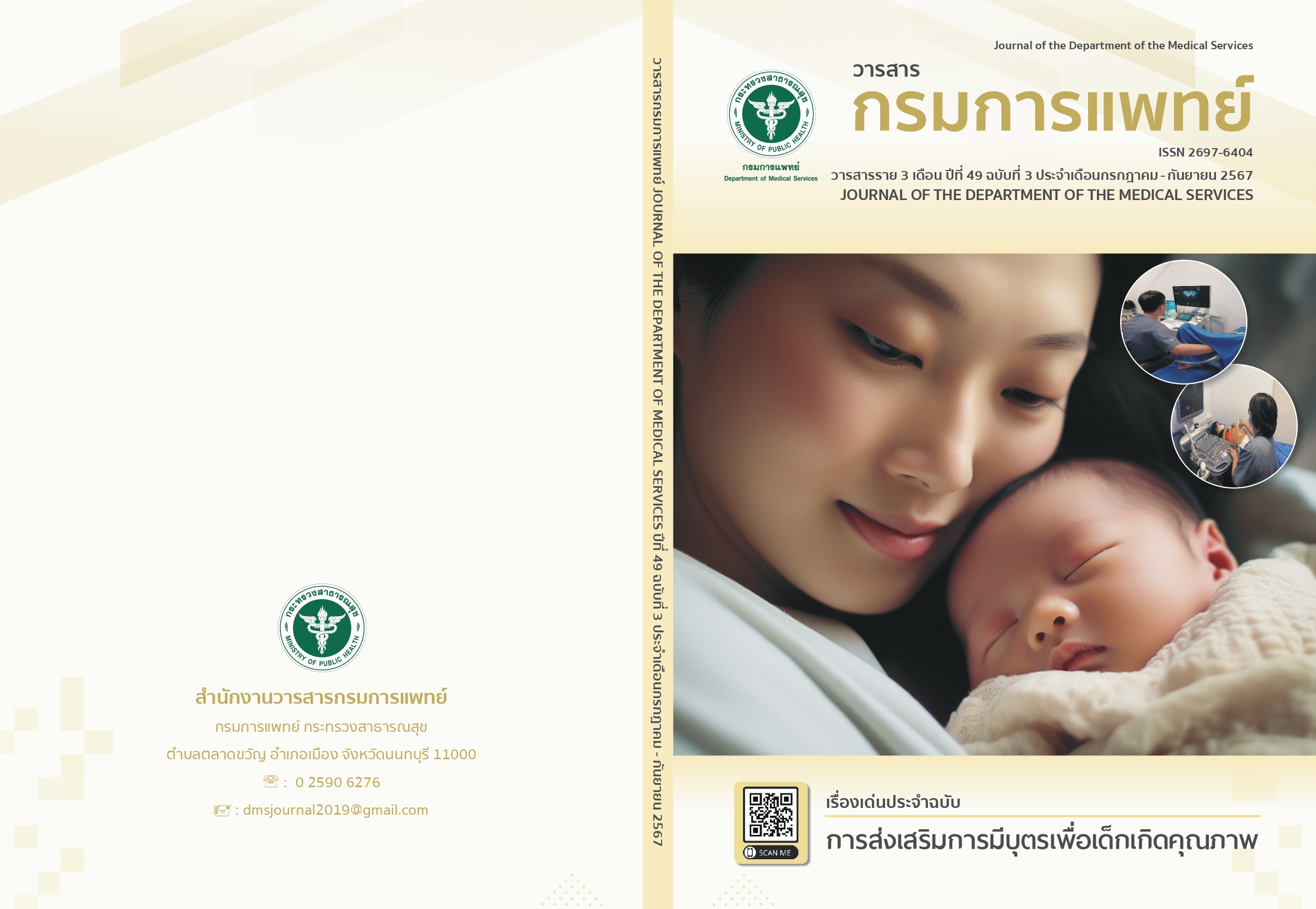ธรรมชาติของปัญหาความร่วมมือในการรักษาด้วยยาของผู้ป่วยโรคไม่ติดต่อเรื้อรังในโรงพยาบาลระดับตติยภูมิ
คำสำคัญ:
ความร่วมมือในการรักษาด้วยยา, โรคไม่ติดต่อเรื้อรัง, อัตราชุก, ยาเหลือใช้, โรงพยาบาลตติยภูมิบทคัดย่อ
ภูมิหลัง: การรักษาโรคไม่ติดต่อเรื้อรังมีเป้าหมายเพื่อควบคุมอาการและป้องกันภาวะแทรกซ้อนด้วยการใช้ยาร่วมกับปรับพฤติกรรม ความไม่ร่วมมือในการรักษาด้วยยาเป็นสาเหตุหลักของความล้มเหลวในการรักษาและเพิ่มค่าใช้จ่ายด้านยา วัตถุประสงค์: เพื่อศึกษาอัตราชุกของความไม่ร่วมมือในการรักษาด้วยยา และประเมินมูลค่ายาเหลือใช้ วิธีการ: ศึกษาเชิงสังเกตแบบพรรณนาที่จุดเวลาใดเวลาหนึ่ง ระหว่างวันที่ 1 ตุลาคม พ.ศ.2563 ถึง 30 กรกฎาคม พ.ศ.2564 เกณฑ์คัดเลือกผู้ป่วยเข้าร่วมการศึกษา คือ เป็นผู้ป่วยโรคไม่ติดต่อเรื้อรัง ได้แก่ โรคความดันโลหิตสูง โรคเบาหวาน และ/หรือโรคไขมันในเลือดสูงอย่างน้อย 1 โรค ที่มารับการรักษาในสถานะผู้ป่วยนอก แผนกอายุรกรรม โรงพยาบาลราชวิถี เกณฑ์คัดออกคือ 1) มีอายุต่ำกว่า 18 ปี 2) มีความผิดปกติทางสมอง และ 3) มีความเจ็บป่วยที่ทำให้ไม่สามารถให้ข้อมูลได้ อย่างน้อย 1 ข้อ มีการสุ่มอย่างเป็นระบบเพื่อคัดเลือกผู้ป่วยเข้าร่วมงานวิจัย จากนั้นใช้แบบสัมภาษณ์ที่พัฒนาและผ่านการตรวจสอบจากผู้เชี่ยวชาญและวิเคราะห์ข้อมูลด้วยสถิติเชิงพรรณนา ผล: มีผู้ป่วยผ่านเกณฑ์คัดเลือก 286 ราย พบผู้ป่วยที่ไม่ร่วมมือในการรักษาด้วยยา 85 ราย (ร้อยละ 29.72) มียาเหลือใช้ 11,341 เม็ด มูลค่า 46,339.14 บาท เฉลี่ย 545.16 บาทต่อราย โดย atorvastatin 40 มิลลิกรัม เป็นยาที่มีมูลค่าของยาเหลือใช้มากที่สุด 12,337.50 บาท ส่วน metformin 500 มิลลิกรัม เป็นยาที่มีจำนวนเม็ดยาเหลือมากที่สุด 1,141.50 เม็ด สรุป: ปัญหาความร่วมมือในการรักษาด้วยยาเป็นปัญหาสำคัญในกลุ่มผู้ป่วยโรคไม่ติดต่อเรื้อรังของโรงพยาบาลตติยภูมิ ผู้กำหนดนโยบายควรวางแผนแก้ไขปัญหาเชิงระบบในการจัดการปัญหาความร่วมมือในการรักษาด้วยยาของผู้ป่วยโรคไม่ติดต่อเรื้อรัง โดยเฉพาะค่าใช้จ่ายด้านยาและส่งเสริมความร่วมมือในการรักษาด้วยยาให้สอดคล้องกับบริบททางสังคมและวัฒนธรรมของผู้ป่วยในประเทศไทย
References
Charoendee K, Boriboon N, Butchumsang A, Rungrueng S, editors. NCDs Annual Report 2022. Bangkok: Aksorn graphic and design publishing limited partnership; 2023.
Division of Non-Communicable Disease, Department of Disease Control. Review of indicators for monitoring the quality of non-communicable disease services, 2020-2023. 2023.
World Health Organization (WHO). Adherence to long-term therapies: evidence for action. Geneva; 2003. p 3-5.
Hansen RA, Kim MM, Song L, Tu W, Wu J, Murray MD. Comparison of methods to assess medication adherence and classify nonadherence. Ann Pharmacother 2009;43(3):413-22.
Kongkaew C. Principles of Effective Collaboration in Medication Treatment. Bangkok: Chulalongkorn University Press; 2018.
Manakitjongkol W. Use of the medication regimen complexity index (MRCI) to assess diabetic outpatient adherence at Saraburi Hospital. Thesis of Master's degree in Pharmacy Program, Clinical Pharmacy. Graduate School, Chulalongkorn University; 2006.
Mongkolchaipak T, Pichayapaiboon S, Sangviroon A. Factors affecting medication adherence of diabetic patients at Police General Hospital. Thai J Pharm Prac 2015;7(1):47-59.
Leaungsomnapa Y, Promproh S, Leaungsomnapa S, Sourthao Y. Influence of beliefs about medication on high group of medication adherence in hypertensive patients. J Prapokklao Hosp Clin Med Educat Center 2013;30(2):146-57.
Horne R, Weinman J. Self-regulation and self-management in asthma: Exploring the role of illness perceptions and treatment beliefs in explaining non-adherence to preventer medication. Psychology Health 2002;17(1):17-32.
Curtis SE, Boye KS, Lage MJ, Garcia-Perez LE. Medication adherence and improved outcomes among patients with type 2 diabetes. Am J Manag Care 2017;23(7):e208-14.
Mongkhon P, Ashcroft DM, Scholfield CN, Kongkaew C. Hospital admissions associated with medication non-adherence: A systematic review of prospective observational studies. BMJ Qual Saf 2018;27(11):902-14.
Capoccia K, Odegard PS, Letassy N. Medication adherence with diabetes medication: A systematic review of the literature. Diabetes Educ 2016;42(1):34-71.
Office of the National Economics and Social Development Council. Quarterly Gross Domestic Product (QGDP). [Internet]. 2019. [cited 2019 Oct. 31] Available from: https://www.nesdc.go.th/nesdb_en/ more_news.php?cid=155.
Cutler RL, Fernandez-Llimos F, Frommer M, Benrimoj C, Garcia-Cardenas V. Economic impact of medication non-adherence by disease groups: a systematic review. BMJ Open 2018;8(1):e016982.
Makki M, Hassali MA, Awaisu A, Hashmi F. The prevalence of unused medications in homes. Pharmacy (Basel) 2019;7(2):61.
Suwannaprom P, Niamhun N, Champoonot P, Phosuya C, Chowwanapoonpohn H, Supakul S, et al. Items and value of household leftover medicines for chronic conditions at Sansai-Luang sub-district, Sansai district, Chiangmai province. Thai Pharm Health Sci J 2012;7(1):22-8.
Dehdari L, Dehdari T. The determinants of anti-diabetic medication adherence based on the experiences of patients with type 2 diabetes. Arch Public Health 2019;77:21.
Najimi A, Mostafavi F, Sharifirad G, Golshiri P. Barriers to medication adherence in patients with hypertension: A qualitative study. J Educ Health Promot 2018;7:24.
Tan CS, Hassali MA, Neoh CF, Saleem F. A qualitative exploration of hypertensive patients' perception towards quality use of medication and hypertension management at the community level. Pharm Pract (Granada) 2017;15(4):1074.
Bailey SC, Oramasionwu CU, Wolf MS. Rethinking adherence: a health literacy–informed model of medication self-management. J Health Commun 2013;18(Suppl 1):20–30.
Thammawut W, Leuvittawat P. Survey on the quantity and value of unused medication in outpatients at the department of medicine, Siriraj Hospital. Siriraj Med Bull 2014;7(1):20-5.
Punnapapaisan W, Kittiboonyakun P, Saramunee K. Designing the system for management of unused medicine in patients with diabetes mellitus by using root cause analysis framework. TJPP 2018;10(2):300-14.
Chantapattarankul P, Thongprong S, Thongmee M. Survey of leftover drugs among patients with chronic diseases at Bangsaphan Hospital, Prachuap Kirikhan. HuaHin Med. J 2018;3(1):119-25.
Srisraluang W, Dilokthornsakul P. The cost and cost saving study of the pharmacy service on leftover medicine in pediatric out-patient: a case study for rheumatism in pediatric patients at Queen Sirikit National Institute of Child Health. J DMS 2019;44(3):58-65.
Downloads
เผยแพร่แล้ว
How to Cite
ฉบับ
บท
License
Copyright (c) 2024 กรมการแพทย์ กระทรวงสาธารณสุข

This work is licensed under a Creative Commons Attribution-NonCommercial-NoDerivatives 4.0 International License.
บทความที่ได้รับการตีพิมพ์เป็นลิขสิทธิ์ของกรมการแพทย์ กระทรวงสาธารณสุข
ข้อความและข้อคิดเห็นต่างๆ เป็นของผู้เขียนบทความ ไม่ใช่ความเห็นของกองบรรณาธิการหรือของวารสารกรมการแพทย์


